 By Hubery Editer
By Hubery Editer
As one of the most widely distributed minerals in nature, calcite is the main constituent of limestone and marble. Its chemical formula is CaCO3, and the crystal belongs to the trigonal carbonate mineral. The aggregates are mostly shaped of granular, massive, stalactite, scorpion, fibrous, and clustered.
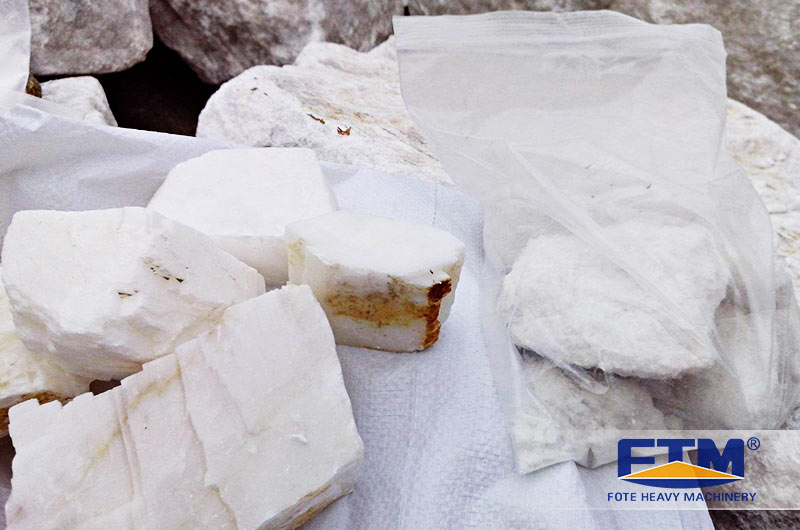
Calcite
It is usually colorless, milk-white, or stained with various colors. With Mohs hardness of 3 and a specific gravity of 2.6-2.9, calcite is one kind of brittle minerals. In the ancient Chinese book "Compendium of Materia Medica", Li Shizhen records its nature: calcite is like a piece of gypsum and can be broken into blocks.
In the limestone area, the calcium bicarbonate dissolved in the solution precipitates calcite under suitable conditions, forming a natural landscape such as stalactites, stalagmites, sarcophagi and stone pillars.
| Formula | CaCO3 |
| Luster | Vitreous, Sub-Vitreous, Resinous, Waxy, Pearly |
| Color | White, yellow, red, orange, blue, green, brown, gray, etc. |
| Mosh Hardness | 3 |
| Specific Gravity | 2.7102 |
| Crystal System | Trigonal |
| Member of | Carbonate Mineral |
Based on the cause of formation, calcite deposits are mainly divided into three kinds, that is, contact metamorphic deposit, regional metamorphic deposit, meso-epithermal filling deposit.
1, Contact Metamorphic Deposit
The contact metamorphic deposit refers to the outer contact zone of the limestone and the late intrusive magmatic rock. This outer contact zone is formed into calcite deposit under the effect of recrystallization and decolorization which is from the separated-out heat and gas-liquid of the magmatism. This kind of deposit is usually in the form of a layer, like-layer, and a small number of lentoid.
2, Regional Metamorphic Deposit
Regional metaphoric deposit means calcite deposit that is formed by regional metamorphism of carbonate rocks in the early stage. It is in the shape of a layer or like-layer with a granular structure and dense massive structure.
The rocks are white fine grain marble, which is mainly composed of about 97-99% calcite, unequally contain a small amount of dolomite, and local contain few sericite, quartz and albite minerals.
3, Meso-epithermal Filling Deposit
Meso-epithermal filling deposit is formed by precipitation and crystallization in carbonate fracture or dissolution structure, which is rich in calcium carbonate solution in carbonate strata. Most of them were veined, and a few were saccular and irregular.
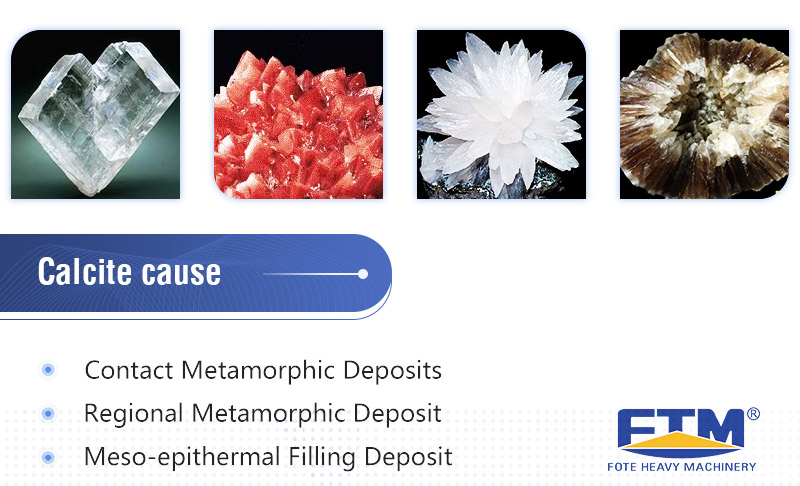
Main Formations of Calcite
Being regarded as a functional filler, it can not only reduce the product cost in various industries but also improve the product function and performance. For these reasons, it is one of the most widely used inorganic additive masterbatches. As the upstream and original material of most industrial manufacturing, you can see it in various walks of life. There are some examples.
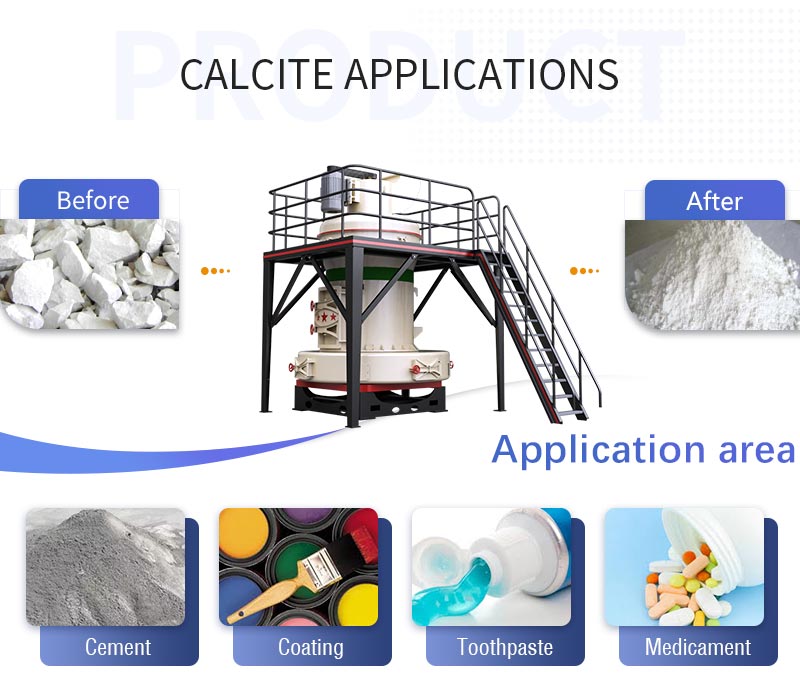
Applications of Calcite Powder
Ball mill is the key equipment to grinding the material after it is broken. As one of the grinding machines that can make ultrafine powder, ball mill is widely used in industrial production, ball mill often plays an indispensable role in calcite processing and production.
It is widely used in industries like cement, silicate products, new construction materials, refractories, chemical fertilizers, black and non-ferrous metals ore dressing, glass and ceramics, etc. Although wet ball mills are more widely used, dry ball mills are recommended for materials like calcite that react with water. The process flow is as follows:
1, If the size of raw material is larger than 20mm or 25mm, a jaw crusher is required to break the raw material into the feed particle size that within the requirement of ball mill feed port.
2, The broken material is then fed into the ball mill by the feeder for grinding. Usually, the grinding medium inside the ball mill is the steel ball.
3, Finally, the finished materials that meet the requirements are excluded through the discharge port and is collected, packaged and stored in the warehouse.
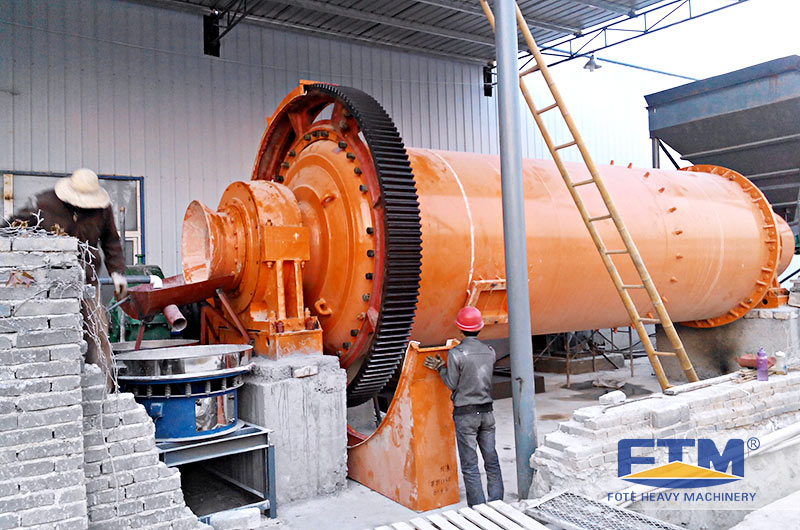
Ball Mill Customer Site
In addition to ball mills, another equipment commonly used in non-metallic ore grinding is the grinding machine. At present, Raymond mill and High-pressure overhang roll mill are more widely used in the market.
The difference between the effect between the Raymond mill and the overhang roll mill is mainly in the feed size, the discharge particle size, and the production capacity. The appearance difference of the main body is small. While the difference can be tole from the grinding roller device inside the main body. That is, there is high-pressure spring is equipped in overhang roller mill while not in the Raymond mill. And just thanks to the set of 1500kg of high-pressure springs, the overhang roller mill gets a great development and improvement.
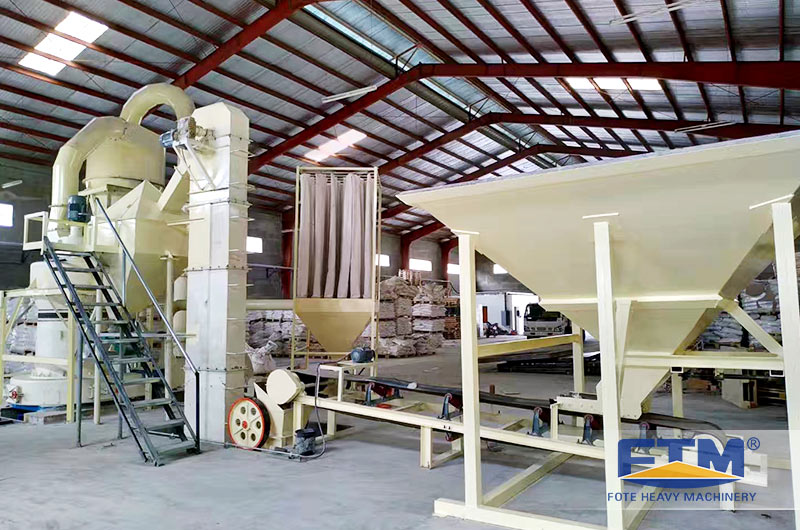
Fine Calcite Powder Production Line Solution
Although there are differences between the two commonly used grinders, the processing process of calcite is the same, which can be divided into three stages: crushing, grinding and separating.
>>Crushing: the large calcite material extracted cannot be ground directly. Here needs a jaw crusher to break it into smaller pieces. Different grinding machines have different requirements for feed granularity. The fineness of crushed product can be set according to the type and model of the grinder, but the fineness of the finished product is generally about 200-800/1000/3000 mesh.
>>Grinding: after crushing, the calcite material which meets the requirements of the feeding particle size of the grinder is sent to the storage bin by the bucket elevator. Then the material is uniformly sent into the body for grinding through the vibrating feeder and the inclined pipe.
>>Separating: ground calcite needs to be screened effectively by the powder separator. The unqualified calcite powder will be sent back to the grinder to continue grinding, while the calcite fine powder which meets the requirements will be collected and packaged.
Both the grinding mill and the ball mill belong to the grinding machine. Each has its own characteristics. Therefore, different equipment can be selected for grinding in different fields.
Generally, the production capacity of the ball mill is strong with higher unit time yield, while the discharge size is generally not more than 200 mesh, so the ball mill is suitable for industries with large production requirements and small particle size requirement.
In contrast, grinding mill is with smaller yield but the larger discharge size, generally in the range of 200-800/1000 mesh, and the discharge size of ultra-fine overhang roller mill can sometimes reach 3250 mesh. Thus, grinding mill is more suitable for industries with strict requirements on particle size such as ceramics, building materials and so on.
| Ball Mill | Grinding Mill | |
| Structure | Horizontal; large weight | Vertical; light quality |
| Capacity | 0.65-700TPH (Customized) | 0.15-35TPH (Customized) |
| Discharge Size | <200 mesh | <3250 mesh |
| Applied Fields | Ore dressing, cement, etc. | Ceramics, building materials, etc. |
| Equipment Price | Higher price and higher operation & maintenance cost | Lower price and lower operation & maintenance cost |
| Functions | Making powder | Making powder; dewatering; separating |
Note:
1, the price comparison of products is based on the same production capacity equipment;
2, the grinding process of different materials is different, please consult the Fote professional engineer for details.
It can be seen from the table that the ball mill is more suitable for the grinding of higher-hardness materials such as metal ores, and the grinding mill is more suitable for non-metallic materials with hardness no higher than Mosh 7.
Therefore, to avoid the overqualification of ball mill, the grinding mill is a better choice in the calcite powder production. Raymond mill, the three-ring and medium-speed micro powder miller and HGM German series mill or European series mill, etc. are more often used in fine calcite powder making line.
The ground powder of calcite is a kind of calcium powder. Different industrial fields need different fineness of calcium powder. The following table is some of these examples for reference.
| Mesh Requirement | Applications | Recommendation of Calcite Grinding Machine |
| <325 | Cement, metallurgical solvents, food additives, etc. | Raymond Mill, HGM130 German Ultrafine Mill |
| 400-800 | Plastic, papermaking, toothpaste, soap, etc. | HGM88 German Ultrafine Mill, High Strength Mill |
| >800 | Rubber, cable, etc. | Three-Rings and Medium Speed Micro Powder Mill |
| >1250 | Paint, coating, ink, etc. | Three-Rings and Medium Speed Micro Powder Mill |
Note: This table lists only a part of the applications of calcite and the corresponding part of the grinding machine recommendation. Please communicate with the Fote engineers online for more details including the latest quotation and customized solution.

Data Sources:
1,Geoscience News and Information: https://geology.com/minerals/calcite.shtml
Articles References:
1, Discussion on the Issues Related to the Upgrade of the Calcite Industry-Taking Guangxi Province as an Example, Author: Chen Chaoxin, etc.;
2, Current Distribution and Characteristics Analysis on the Type of Calcite Deposits in Anhui Province, Author: Huo Lixin;
3, "DZ/T 0321-2018 Calcite Mine Geological Exploration Norm"
 Online Chat
Online Chat